Table of Contents
- What is EdTech?
- Key EdTech Statistics
- Global Game-Based Learning Market
- EdTech Industry Trends Statistics
- EdTech in College Statistics
- EdTech Adaptive Digital Learning Statistics
- Top 10 EdTech Unicorns Worldwide Statistics
- EdTech Revenue and Age Group Demographics of Top 4 Unicorns Statistics
- Online Education Worldwide Statistics
- EdTech Market in India Statistics
- E-Learning and Digital Education Statistics
- How Technology Impacts Educational Outcomes
- Technology Types in US Classroom
- Challenges in EdRTech
- Digital Divide EdTech Statistics
- Recent Developments
- Wrap Up
- Frequently Asked Questions
EdTech statistics will help you to show how technological advancements are emerging in education and supporting teaching & learning processes.
Education is one of the largest industries, making up 6% of GDP. The EdTech industry is a rapidly growing sector that is revolutionizing the way students learn and get knowledge.
Virtual classrooms, online courses, and Zoom lectures form a strong EdTech infrastructure. Artificial Intelligence (AI) and game-based learning made EdTech more effective and applicable in the education sector.
Together, those technologies are changing the way people learn- from early childhood to professional life.
To get detailed knowledge of future technology in education, we need to know what’s going on now. Before getting insights into educational technology statistics let’s take a look at what is EdTech.
What is EdTech?
The EdTech (Educational Technology) industry is a rapidly growing sector that is revolutionizing the way students learn and acquire knowledge. EdTech companies are providing various educational tools and services that leverage technology to enhance and facilitate learning.
We have seen tremendous changes in recent years in the Edtech industry, which is forming the way for a new wave of technology and online learning for EdTech developers, learners, and instructors alike. Let’s take a deep look at EdTtech Statistics.
Take advantage of our unbeatable offer - buy now!

Key EdTech Statistics
- The Global EdTech Market size is expected to be worth around USD 549.6 Billion by 2033, from USD 146.0 Billion in 2023, growing at a CAGR of 14.2% during the forecast period from 2024 to 2033.
- The global education software/application market accounted for revenue of USD 11,039 million in 2022 and the market is expected to hold revenue of USD 11,610 million in 2025.
- Education is a USD 6.5 T industry only in the early days of its digitization.
- EdTech usage among K-12 schools has increased by 99% since the year 2020.
- More than colleges expect to launch one or more online undergraduate programs in the next three years.
- 36% of teachers have heard of EdTech but don’t know what is EdTech.
- 14% of teachers have never heard about educational technology.
- 60% of academy school teachers don’t think there is enough training for EdTech.
- 75% of Northern Irish teachers report not having enough access to EdTech.
- 37% of UK teachers have purchased tech supplies for students.
- 79% of teachers surveyed are using EdTech each day.
(Source: exploding topics, Statista, deal room, global-edtech)

Global Game-Based Learning Market
In 2022, the global game-based learning market was valued at USD 11.5 billion and is expected to reach USD 77.4 billion between 2023 and 2032, this market is estimated to register the highest CAGR of 21.6%.
(Source: Market.us)
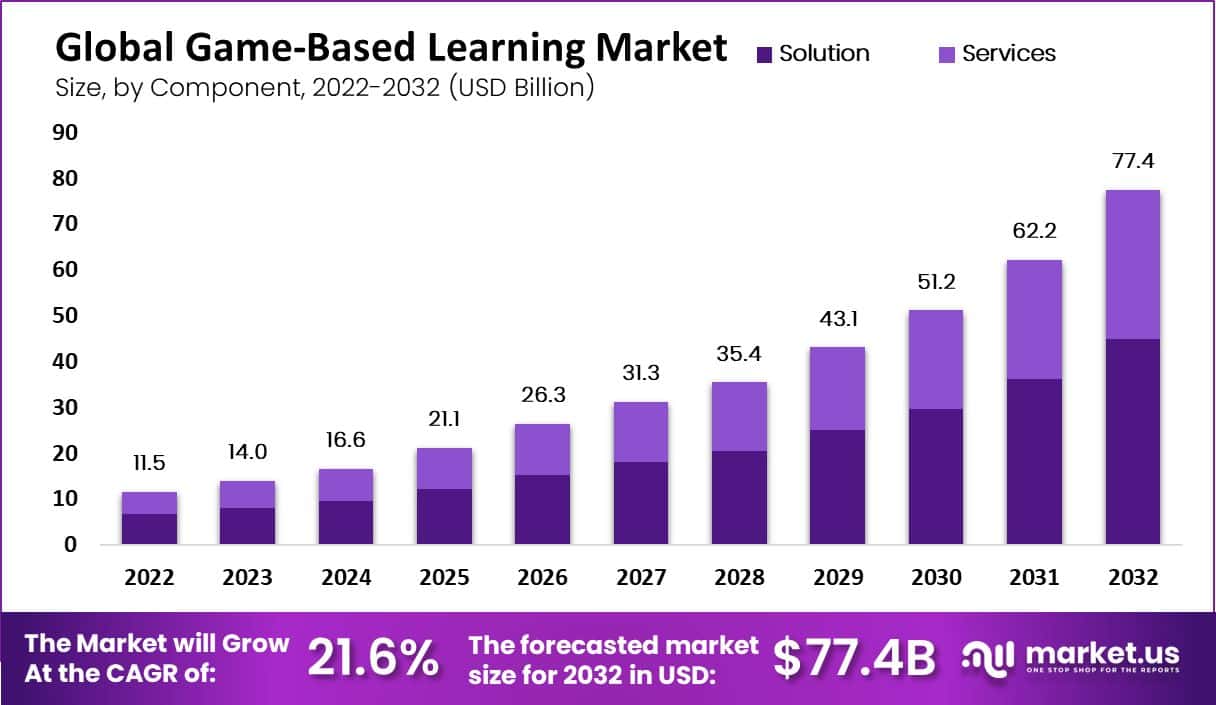
EdTech Industry Trends Statistics
- More than 65% of faculty support the use of pen educational resources in teaching.
- 3 out of 5 K12 teachers plan on continuing to give online assignments after the COVID-19 pandemic.
- 1-3rd of K12 school systems will make fully remote learning an option after the pandemic.
- US K-12 school districts access 1403 EdTech solutions on average each month.
- 80% of college students say EdTech solutions helped them to improve their grades.
(Source: Statista, exploding topics)
EdTech in College Statistics
Technology plays an important role in student’s study behaviors.
- 70% of students say that technology is important to study on mobile electronic devices.
- 81% of students said that technology is important for doing homework.
- 79% of students said that technology helps prepare for exams/tests.
- 71% of respondents most strongly agree that technology increases their engagement with course materials.
- 58% of professors said that technology is helpful in the teaching process.
(Source: info DOCKET)
The majority of respondents believe that digital learning technology (DLT) is beneficial
- 81% of students agree that DLT improves their grades.
- 82% of students said that DLT allows them to spend more time studying.
- 81% of students respond that DLT improves the efficiency of study.
- Less than half of the college students surveyed (39%) report that they would purchase DLT if it was recommended.
- 89% of students agree that DLT should be adaptive to their learning style.
- 49% of students agree that DLT personalization is very important.
- 62% of students responded that analytics for the course would have a very positive impact on their learning experience.
- 47% of students are now using academic performance tracking technology.
(Source: info DOCKET)
Students’ view on the amount of digital learning technology (DLT) in their schoolwork
- 70% of students said that they use the right amount of digital learning technology.
- 18% of students said that they would like to use more digital learning technology.
- 12% of students said that they would like to use less digital learning technology.
(Source: info DOCKET)
Students’ view on the amount of digital learning technology (DLT) in their schoolwork

EdTech Adaptive Digital Learning Statistics
- 33% of college students said that DLT is very important to adapt to their unique learning goals.
- 31% of college students said that DLT is moderately important in education.
- 16% of college students said that DLT is extremely important in learning.
- 15% of college students respond that DLT is slightly important in education.
- 5% of college students respond that DLT I not at all important in the learning process.
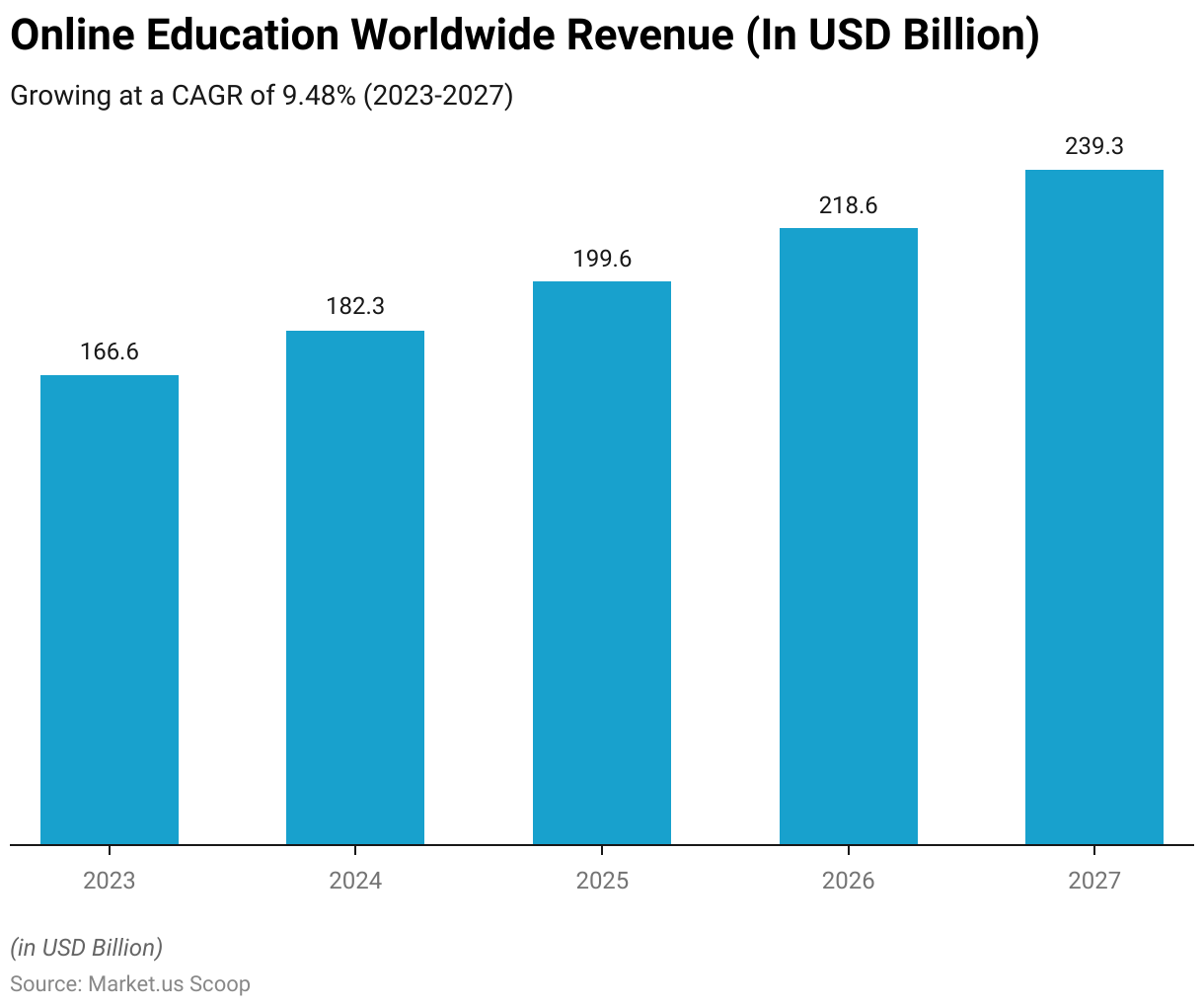
Top 10 EdTech Unicorns Worldwide Statistics
- ByJu’s (India)
- BetterUp (United States)
- Guild Education (United States)
- Articulate (United States)
- Course Hero (United States)
- Handshake (United States)
- GoStudent (Austria)
- UnAcademy (India)
- Eruditus (India)
- ApplyBoard (Canada)
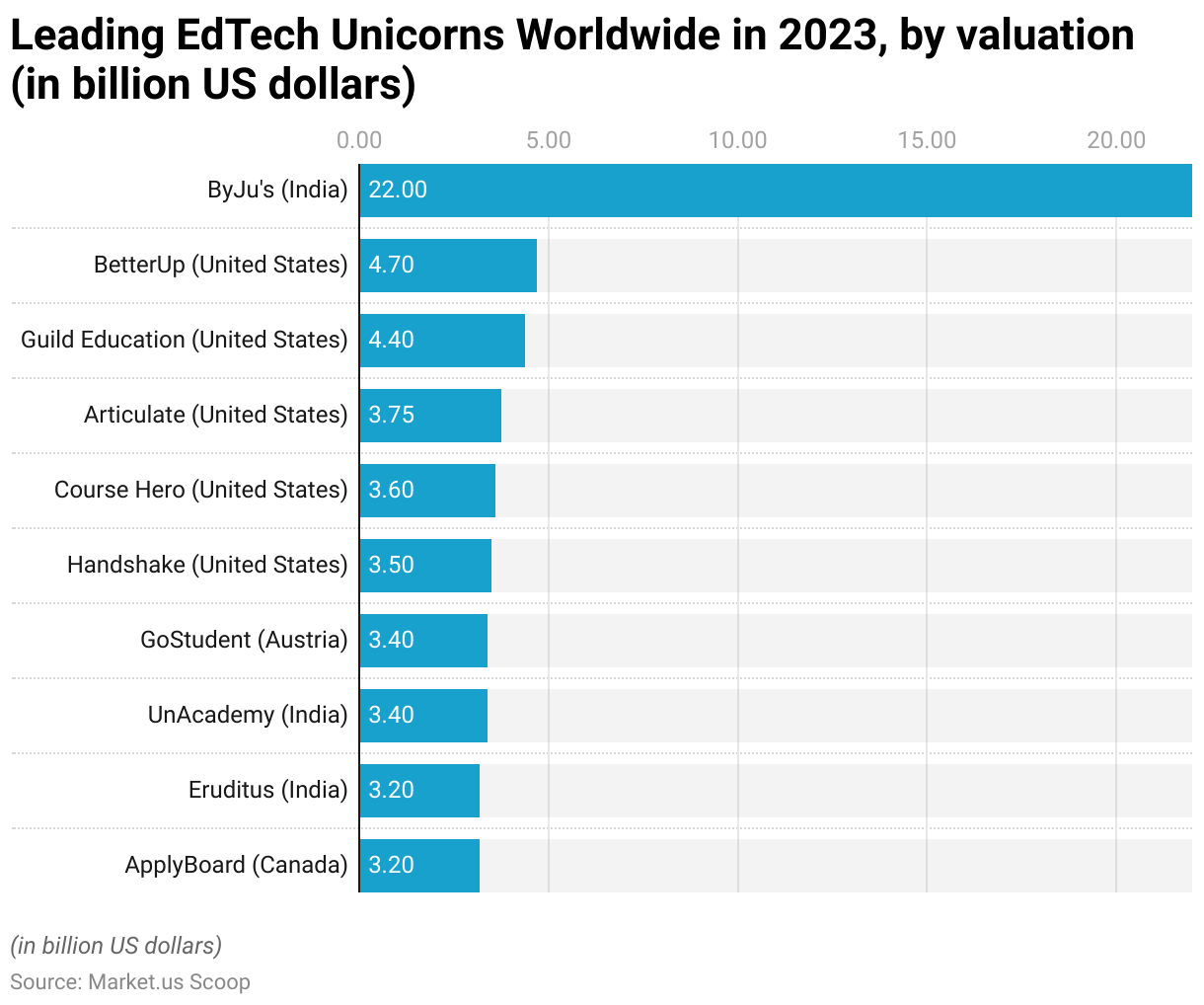
EdTech Revenue and Age Group Demographics of Top 4 Unicorns Statistics
ByJu’s (India)
Byjus.com Audience Demographics, by Age Group
byjus.com’s global ranking has increased by 335 to 406. byjus.com’s audience is 50.61% male and 49.39% female. The largest age group of visitors is 18 – 24-year-olds.
(Source: Similarweb)
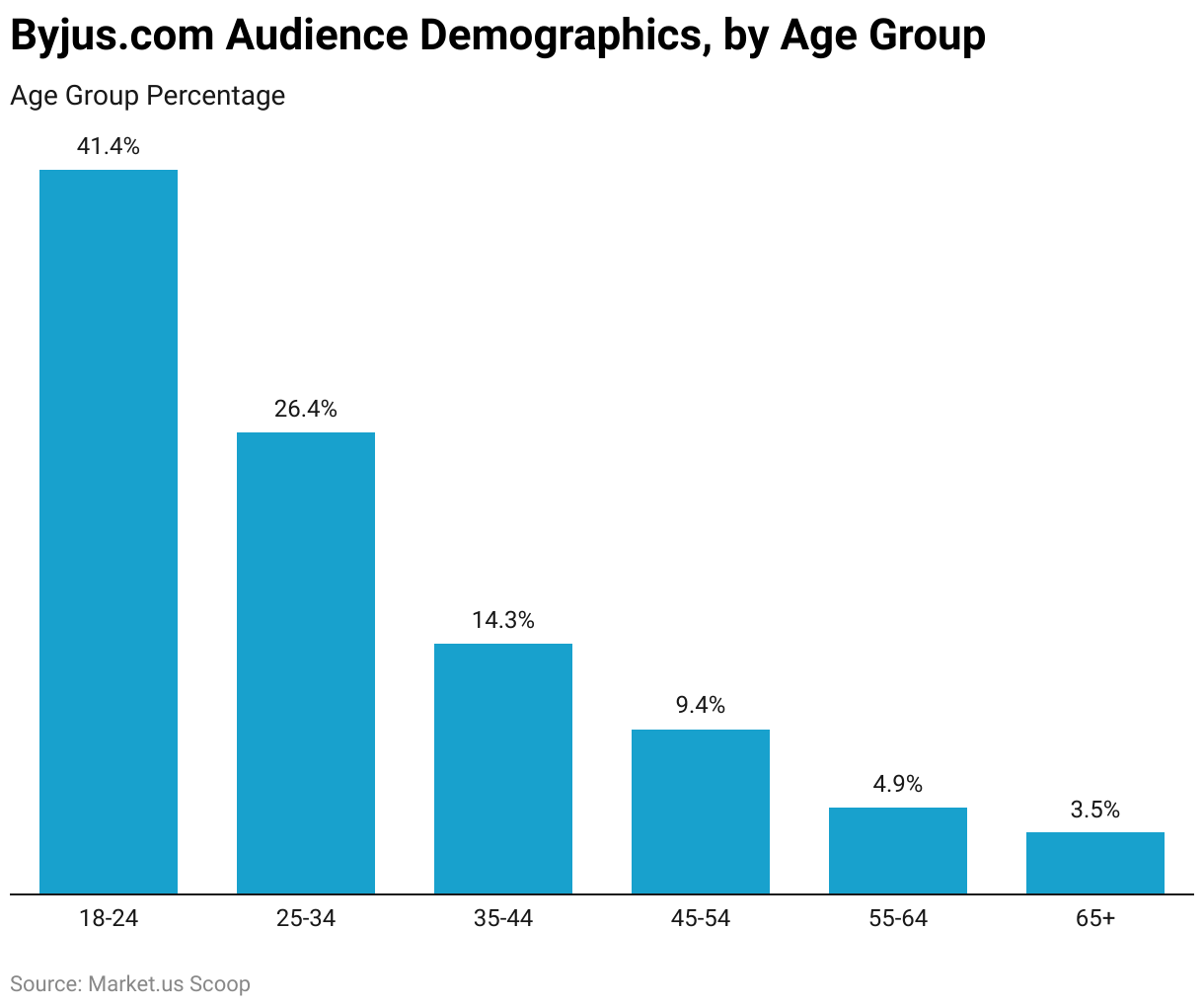
BetterUp (United States)
betterup.com Audience Demographics
- Revenue of BetterUp (United States) is expected to reach USD 4.7 Billion at the end of year 2023.
- Betterup.com’s audience is 47.27% male and 52.73% female. The largest age group of visitors is 25-34-year-olds.
(Source: Statista, Similarweb)
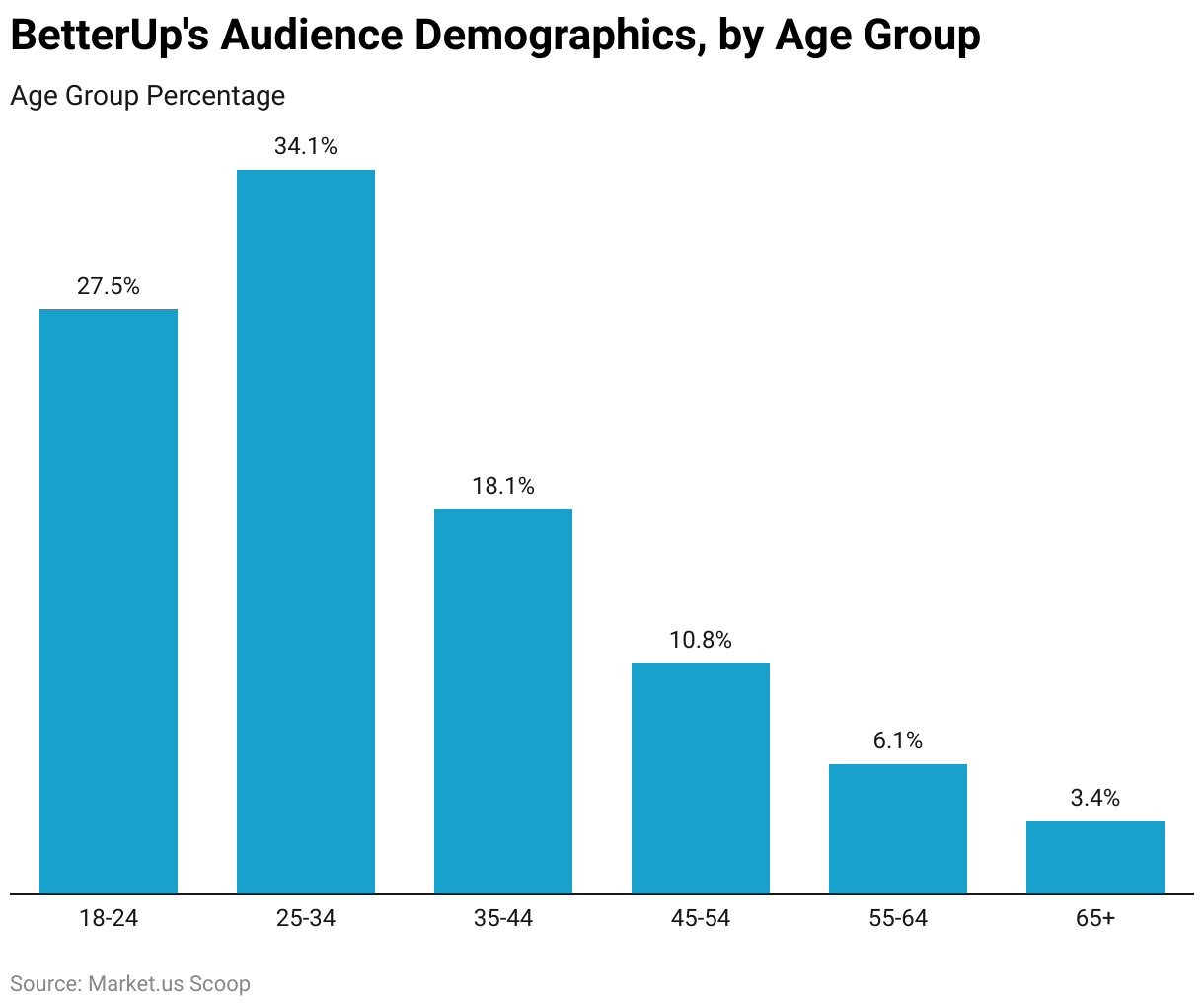
Guild Education (United States)
- The Guild Education (United States) is expected to grow at a revenue of USD 4.4 billion at the end of the year 2023. Users of guildeducation.com are 66% men and 34% of women.
(Source: similarweb)
Articulate (United States)
articulate.com Audience Demographics
- The articulate is expected to grow at a revenue of USD 3.75 billion at the end of the year 2023. articulate.com traffic has increased by 12.27% compared to last month.
- articulate.com’s audience is 50.60% male and 49.40% female. The largest age group of visitors is 25 – 34-year-olds.
(Source: similarweb)
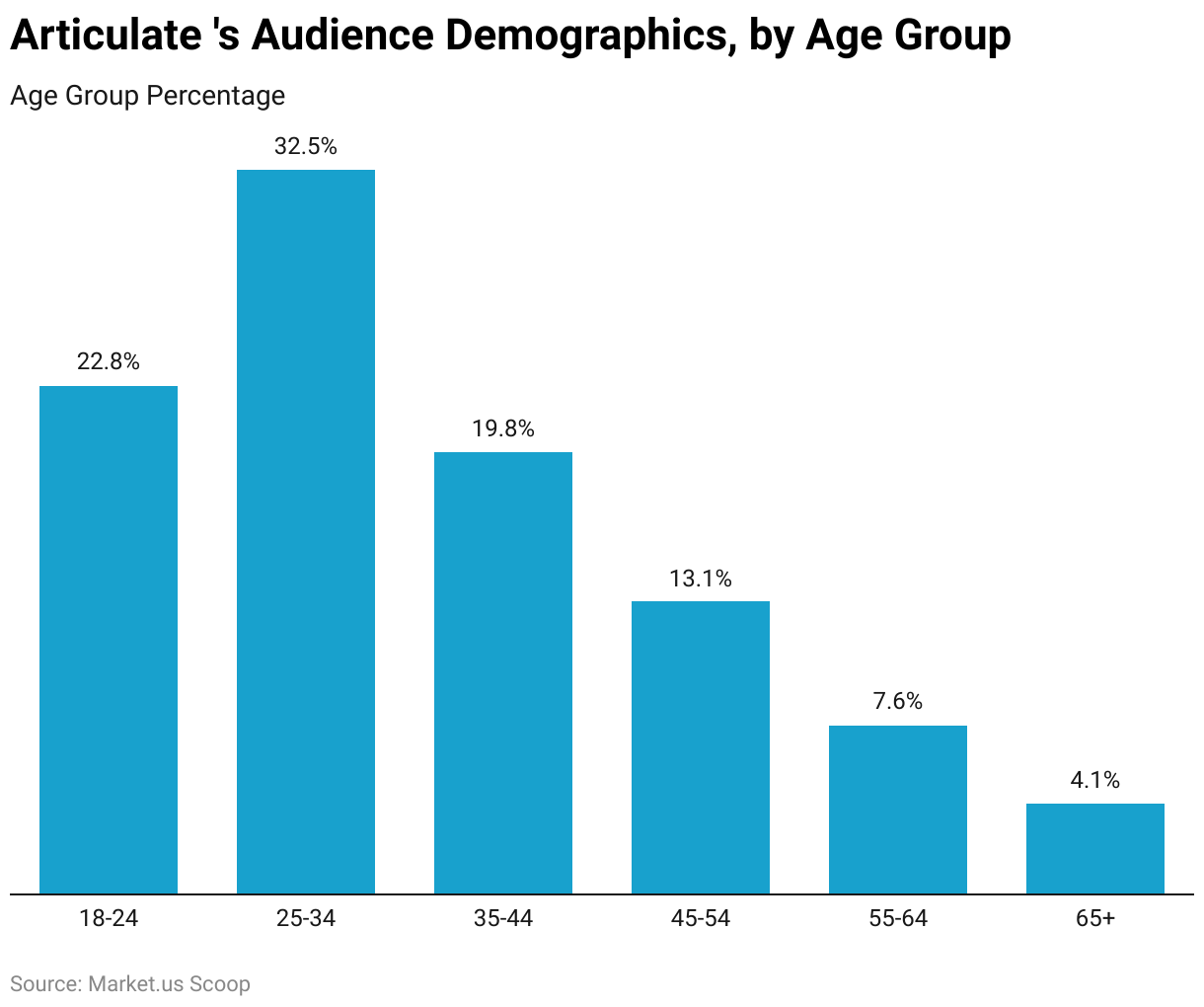
Online Education Worldwide Statistics
- Revenue from online education is projected to reach USD 166.60 Billion in 2023.
- The revenue is expected to show an annual growth rate (CAGR 2023-2027) of 9.48% resulting in a projected market volume of USD 239.30 billion by 2027.
- The market’s largest segment is online university education with a projected market volume of USD 103.80 billion in 2023.
- Most of the revenue is generated in the United States.
(Source: Statista)
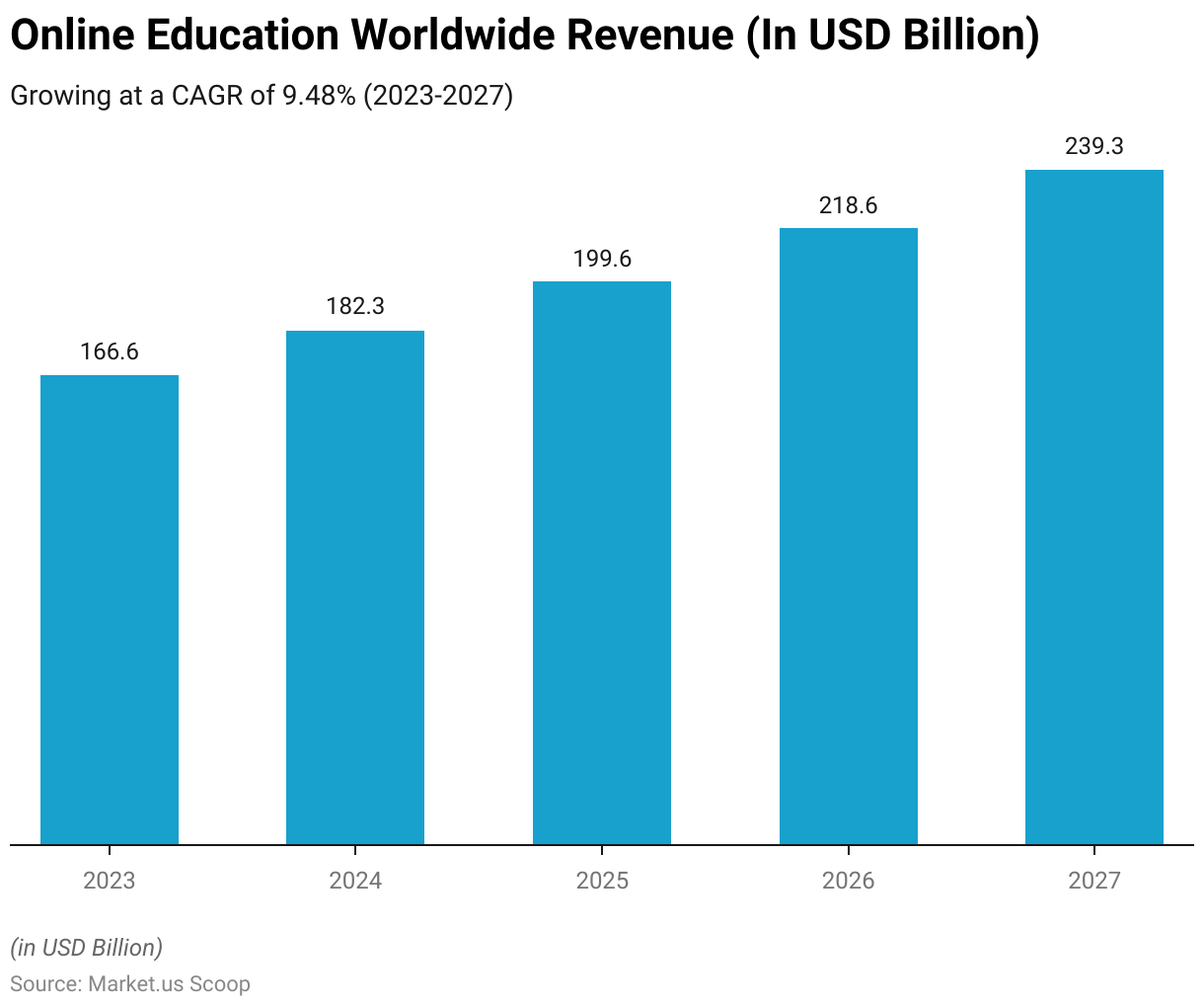
EdTech Market in India Statistics
- In 2020, the K-12 grade education market had a market value of USD 1.16 billion.
- The skill development market was worth less than USD 500 million.
- In 2020, the whole market was worth USD 2.8 billion, by 2025 the overall market is expected to reach USD 10.4 billion.
(Source: Statista)
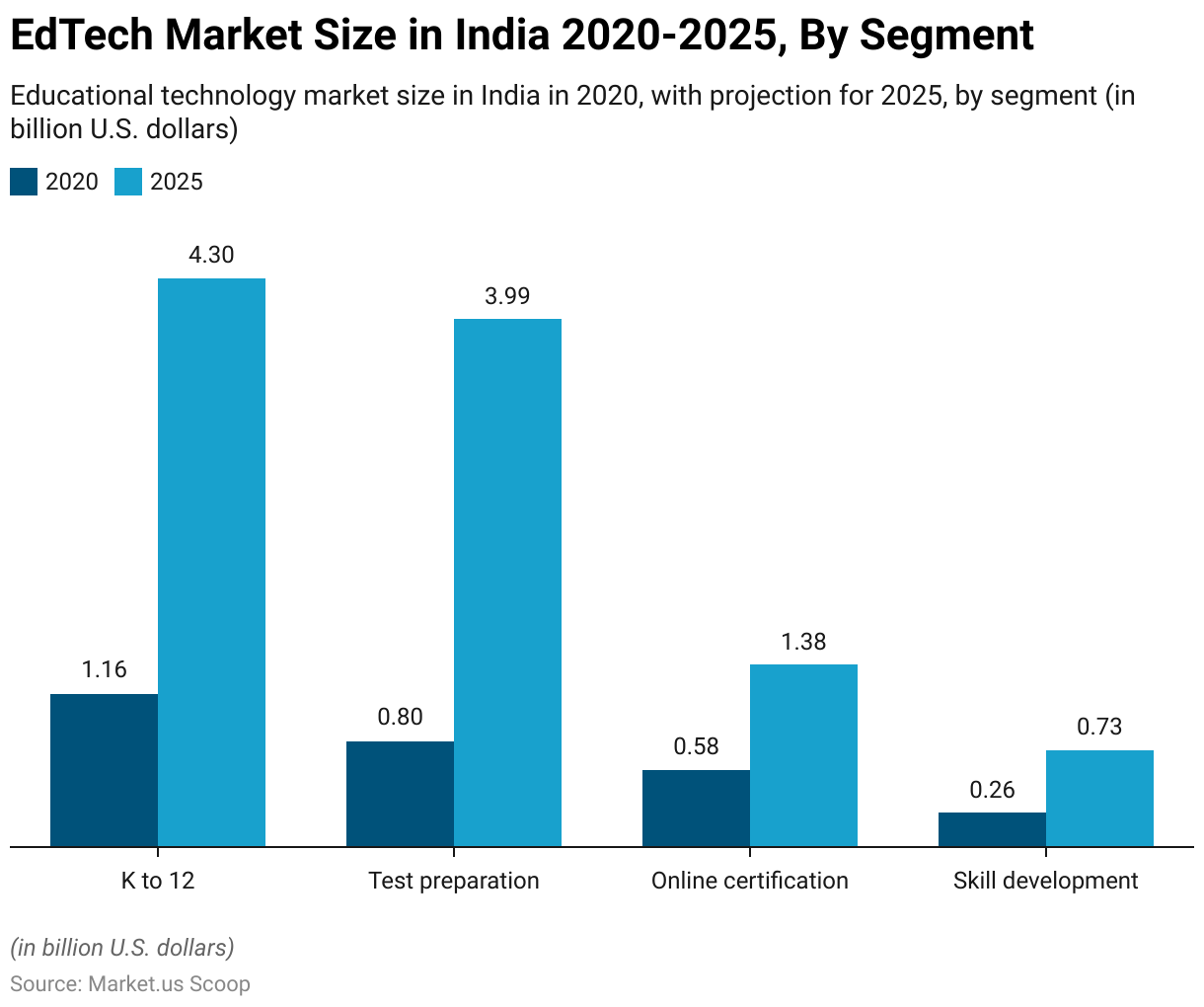
E-Learning and Digital Education Statistics
Technology has changed possibilities within teaching and learning. Classes, which before the digital era were restricted to lectures, talks, and physical objects, no longer have to be designed for that matter.
Digital education is the term that refers to online courses and digital textbooks.
- The E-learning market worldwide is forecast to surpass USD 243 billion by 2022.
- The self-paced e-learning product market accounted for revenue of USD 33.5 billion in 2022.
- About 65% of education faculty supports the use of open educational resources (OERS) in teaching.
- 63% of faculties showed support for a competency-based education system.
- 92% of students worldwide are interested in personalized support and information on degree progress.
- About 56% of students worldwide wanted their instructors to enable them to use their laptops more in a learning context.
- About 56% of students stated using a laptop or desktop computer in the classroom every week.
- 49% of students stated that they had taken an online course in the last 12 months.
- 47% of students started taking this type of course.
- 73% of students in the world are not aware of massive open online courses.
- 11% of students earned a competency-based badge.
- 19% of students said they would use the competency-based digital badge on their resumes.
(Source: Statista)
Views on the helpfulness of digital study technologies according to college students in the United States
- These statistics present views on the helpfulness of digital study technologies for college students.
- 43% of college students stated that they found digital study technologies extremely helpful for doing their homework.
(Source: Statista)
EdTech in the United Kingdom Statistics
- The United Kingdom is the leading country in the EdTech market due to technological advancements in the education sector. The United Kingdom invested more and more in the EdTech industry to make strong infrastructure.
- In 2022, the United Kingdom invested USD 583 million in the EdTech industry and became the largest investor in EdTech in the globe.
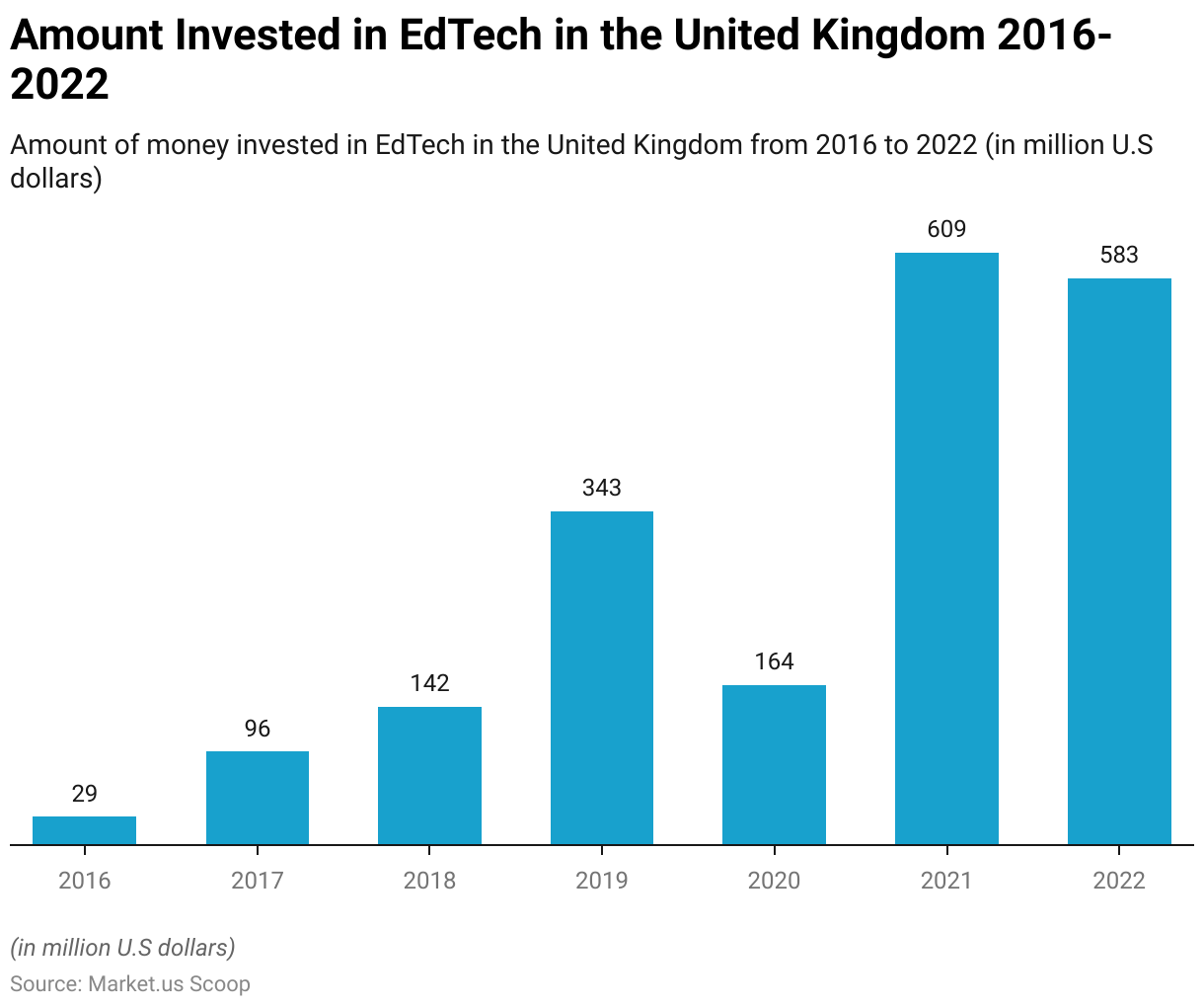
How Technology Impacts Educational Outcomes
- In North America, data projectors have a more positive impact on in-person educational outcomes as compared to laptops, computers, or tablets.
- 32% of US teachers prefer smartphones for school assignments.
- Gamification can improve educational outcomes by 45.4%.
- Challenge-based gamification in e-learning can improve educational outcomes by 89.4%.
- 53% of teachers believe that students’ increased access to an individual computer makes teaching easier, especially with school courses.
(Source: get stream)
Technology Types in US Classroom
- More than 71% of US students use laptops in the classroom.
- 56% of US students reported that they are using a laptop at least once a week in the classroom.
- 26% of US teachers reported that their students used school-provided computers in the classroom.
- 40% of teachers reported that some students are not able to take them home.
- 8% of teachers reported that the school districts provided a hotspot for students.
- 2.5% of US K-12 students, as of April 2020, used district-provided internet to access online learning from home.
(Source: Statista, McKinsey, USA Facts, NCES)
Demand for EdTech will be further supported by fundamental drivers that enable growth opportunities
Young and growing student population
- The Indian demography is defined by its youth 42% of countries 1.3 billion population consists of individuals below the age of 18 years.
- The total number of K-12 and HE students is expected to increase from 310 million in 2020 to 320-325 million by 2025 with a compound annual growth rate of 2%.
(Source: PWC)
Lower cost of data
- The cost of data in India is the lowest in the world- approximately (USD 0.26) per GB a month, compared to USD 12.37 in the U.S. enabled by a rapid reduction in the cost of internet services.
(Source: PWC)
COVID-19 has accelerated the integration of technology in education by changing mind-sets, much needs to be done to retain the interest and bridge any digital gaps
The COVID-19 pandemic had a significant impact on the EdTech industry. With schools and universities around the world forced to close their physical campuses and switch to remote learning, there has been a massive surge in demand for online education tools and platforms.
The demand for EdTech tools and platforms has surged since the COVID-19 pandemic. With the closure of physical campuses schools and universities adopted remote learning solutions to continue providing education to students.
Edtech Insights and Statistics:
- At the peak of COVID-19, more than 90% of the world’s schools and most of the colleges and universities shifted to online teaching.
- The use of online teaching platforms such as Zoom, Google Classrooms, and Microsoft Teams increased during the pandemic.
- By April 2020, approximately 1.7 billion students were studying remotely.
- According to UNESCO monitoring, 191 countries implemented nationwide closures affecting around 98% of the world’s student population.
- Google Classroom which allows teachers to send lessons and materials to students, doubled its users to 100 million in March 2020.
- Byju’s which is an Indian online learning app, added 6 million new users in the same month.
- In China Koolearn, GSX, and YouDao– the three pure online after-school tutoring services, each had over 10 million enrolments in free courses during the coronavirus crisis.
- In Brazil, Estacio registered a 55% growth in pure online distance learning student enrolment in 2020.
- In the United States, Chegg saw a 35% increase in subscriptions to its online learning services.
- According to the language learning app, Duolingo traffic typically spiked 3 to 5 days after the introduction to lockdown.
- Traffic doubled first in China, then Corea, and then increased by 135% in Spain, 100% in Italy, and 90% in the US.
- Before the crisis, the penetration of online tutoring in China was between 15% to 25%.
- The app download in China has soared to 127 million in 2029.
- By the end of 2019, just under one-third (31%) of EdTech companies had successfully attracted VC funding, with 1,019 enterprises in the industry attracting a total of USD 14bn.
(Source: Credit Suisse)
Challenges in EdRTech
Challenges in EdRTech: Mental Health, Digital Divide, and Commodification of Education Statistics
- The global COVID-19 pandemic was thought to become a big moment for educational technology. When most of the schools, colleges, and universities were closed students shifted towards online learning.
- Still, the EdTech sector is facing a range of challenges that are expected to overshadow future technology developments. Lack of internet connectivity is still a big barrier to the adoption of EdTech.
Mental Health After COVID-19
- During the last few years, America has witnessed a historically high rate of mental health problems among the population.
- At the beginning of the last few years, 40% of adults reported the symptoms of anxiety and depression. This rate of anxiety and depression was high in 2019.
- The Children’s Hospital Association reported 47,000 mental health visits in the first 3 months of 2021.
- The number is almost 40% higher than within the same span in 2020.
(Source: jatapp)
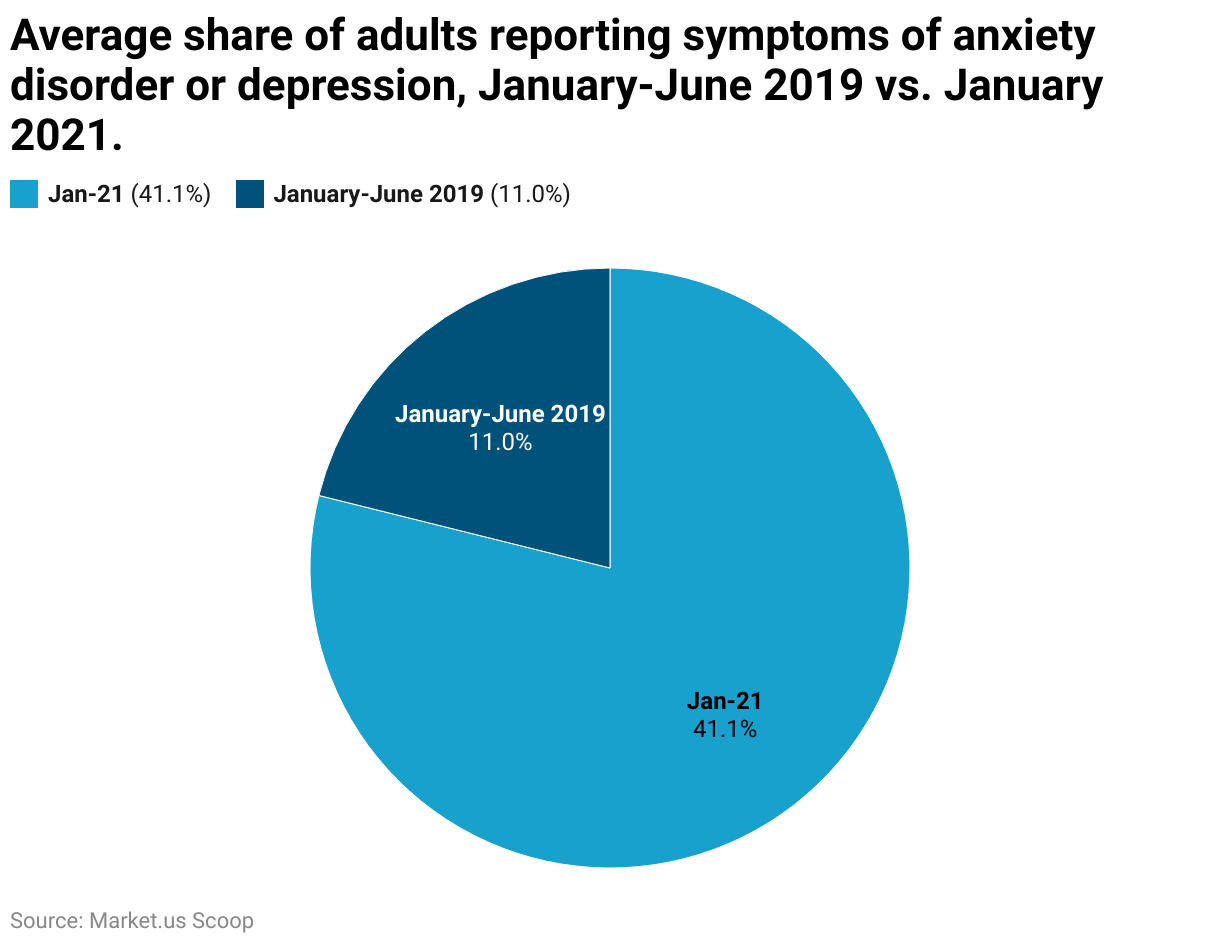
Digital Divide EdTech Statistics
- Today, 87% of households have a smartphone, computer, or tablet, while only 73% of families enjoy a stable internet connection.
- During the COVID-19 pandemic, people without access to the internet have found many issues in online learning.
Recent Developments
Acquisitions and Mergers:
- Coursera acquires Rhyme Softworks: Coursera announced the acquisition of Rhyme Softworks, a platform for hands-on coding and technical skill development, to enhance its offerings in practical, project-based learning.
- Udacity merges with Degreed: In early 2024, Udacity merged with Degreed to create a comprehensive platform that integrates both microlearning and traditional skill-building pathways, aiming to address the skills gap in the workforce.
New Product Launches:
- Google Classroom introduces AI-driven features: Google Classroom has integrated AI functionalities to provide personalized learning experiences, including automated grading and tailored content recommendations.
- Blackboard’s Virtual Reality Suite: Blackboard has launched a new suite of virtual reality (VR) tools to create immersive learning environments, allowing for virtual field trips and interactive simulations.
Funding:
- Khan Academy receives $50 million from the Gates Foundation: Khan Academy secured significant funding from the Gates Foundation to expand its free educational resources and integrate advanced AI tutoring systems.
- Byju’s raises $250 million: Byju’s, an Indian EdTech giant, raised $250 million in a funding round led by Silver Lake to enhance its international expansion and develop new learning technologies.
Technological Trends:
- AI-Assisted Learning: AI continues to transform EdTech by providing personalized learning experiences and virtual tutoring. Tools like ChatGPT are being integrated to assist students in areas like writing and language learning.
- Augmented Reality (AR) and Virtual Reality (VR): AR and VR are increasingly used to create immersive learning experiences, making complex concepts more tangible and engaging through virtual simulations and interactive content.
Market Dynamics:
- Rise of Micro Degrees: There is a growing trend towards micro degrees, offering bite-sized, specialized courses that cater to specific skills or knowledge areas. This modular approach allows for continuous skill development and aligns with industry demands.
- Emphasis on Mental Health: EdTech platforms are incorporating features to support mental health and well-being, such as mindfulness exercises and stress management tools, creating a holistic educational experience.
Regulatory and Strategic Developments:
- Blockchain for Academic Credentialing: Blockchain technology is being adopted for secure and transparent storage of academic records, ensuring the authenticity of qualifications and simplifying the sharing of verified credentials.
- Reduction in EdTech Tools: Schools are streamlining their use of EdTech tools to reduce complexity and enhance cybersecurity, focusing on integrating fewer, more effective platforms.
Wrap Up
EdTech Statistics – The field of EdTech is rapidly growing and evolving as technological advancements in education. EdTech has the potential to revolutionize the way to learn and teach, making education more accessible and personalized.
Additionally, EdTech can provide a more personalized learning experience to students, allowing them to learn at their own pace and preferred style.
However, there are also some challenges in the adoption of EdTech. One of the biggest challenges in EdTech is the lack of internet connectivity.
Also, there are concerns about the equality of educational content delivered through the EdTech platform. Overall, EdTech has the potential to transform education for the better education. Rising technological advancements in the education sector booming the adoption of EdTech.
Frequently Asked Questions
The EdTech (Educational Technology) industry is a rapidly growing sector that is revolutionizing the way students learn and acquire knowledge. EdTech companies are providing various educational tools and services that leverage technology to enhance and facilitate learning.
The COVID-19 pandemic had a significant impact on the EDTech industry. With schools and universities around the world forced to close their physical campuses and switch to remote learning, there has been a massive surge in demand for online education tools and platforms.
The EdTech sector is facing a range of challenges that are expected to overshadow future technological developments. Lack of internet connectivity is still a big barrier to the adoption of EdTech.
EdTech can provide benefits to both teachers and students. It can help increase engagement and motivation, provide a personalized learning experience, and offer flexibility in terms of location and time.
There are many popular Edtech tools available today, such as
Learning management systems (LMS) like Blackboard, Canvas, and Moodle
Online learning platforms like Khan Academy, Coursera, and Udemy
Educational apps like Duolingo, Quizlet, and Kahoot!
Interactive whiteboards like SMART Board and Promethean Board
Video conferencing tools like Zoom, Microsoft Teams, and Google Meet
Students can benefit from using EdTech in various ways such as:
Accessing educational resources from anywhere at any time
Engaging in personalized learning experiences
Improving their digital literacy skills
Receiving immediate feedback on their work
Collaborating with peers on projects and assignments
Discuss your needs with our analyst
Please share your requirements with more details so our analyst can check if they can solve your problem(s)



